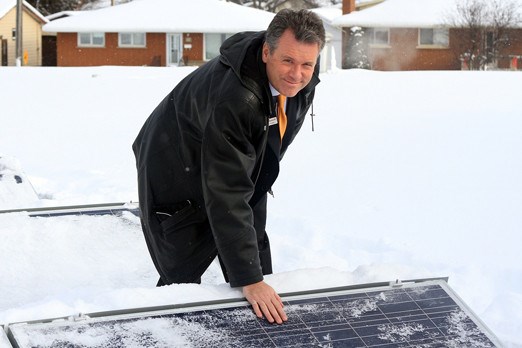With an eye on future savings, the Thunder Bay Catholic District School Board is making a direct attack on rising energy costs.
On Tuesday the board announced a $770,000 provincial grant will be used to install 272 roof-mounted solar-energy panels atop Pope John Paul II Senior Elementary School, which officials estimate will save the school $70,000 a year in electricity costs.
That’s money that can be put to better use, said Tom Mustapic, associate director and superintendent of business for the TBCDSB.
“We’re actually to use those funds to do something unique at the school, probably more mobile technology, the implementation of iPods and iPads and so on,” Mustapic said. “We’ve got a program in place now and we can use the savings to introduce more of that type of technology to our schools.”
Grade 8 student Nicholas Chiappetta is taking a more planet-friendly view of the project, an extension of similar ones done at two other Thunder Bay schools.
“I think it’s really good that we’re taking a step to help the environment. And I think it’s going to provide an example for other schools,” he said.
“It’s tough times and energy’s short. You’ve got to do what you can to help the environment.”
MPP Bill Mauro (Lib., Thunder Bay-Atikokan) said this is exactly why the province is supporting the program through its renewable energy fund.
The day is coming, Mauro said, when Ontarians won’t have any choice but to seek out alternative energy sources, and it’s better to be ahead of the curve than trying to catch up down the road.
“We grew up in an era where there were lots of everything, whether it was trees or oil or natural gas, and because there was lots, it was cheap. And with diminishing resources – it’s harder to get the oil out of the ground – the point is it’s become very expensive,” Mauro said.
He pointed out that when the initial infrastructure cost savings are realized – in this case after about 11 years or so – the energy then becomes almost free for the user, who sells the energy produced back to the grid and receives credit toward power used.
Mauro said it’s a cost Ontarians should be willing to pay.
“It’s renewable, it’s sustainable and it’s environmentally a good thing to do. We don’t really have a choice. We need to move in that direction. We’re always going to rely on some of the traditional sources, but we need to be able to have energy sources that we can count on for sure, so that industry will be here and stay here,” he said.
“But we need that mix and we have to try to do it as quickly as we can. And I really do love that part that as a school they plan on using this as a teaching thing for the younger students here, because they’re the next generation that’s really going to have to grapple with what’s left behind.”
Honeywell Building Solution’s Luis Rodrigues, whose company will install the 50-kilowatt solar photovoltaic system, said the system is guaranteed for a dozen years.
He added the partnership with the school board goes back six years, when the board decided to look at ways of reducing costs and energy consumption.
It’s become more than just pinching pennies, Rodrigues said.
“It really also is about demonstrating environmental leadership. It is around connecting it to a learning environment, because students will be able to take advantage of the systems that have been installed and it complements their learning.”
The installation includes a sustainability dashboard that provides students and teacher real-time data and graphs that demonstrate not only the electricity being generated, but also the impact on the school’s carbon footprint.
Sign in or register
- Messages
- Post a Listing
- Your Listings
- Your Profile
- Your Subscriptions
- Your Likes
- Your Business
- Support Local News
- Payment History
Registered Users
Already have an account?
New Users
Create a free account.
